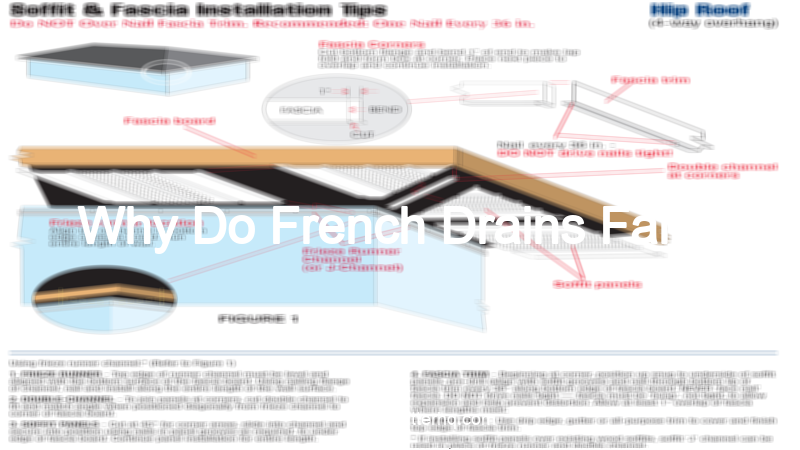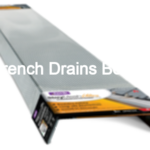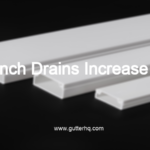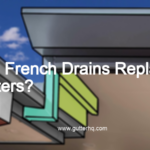French drains are one of the oldest and most popular methods of dealing with excess water on your property. However, they are not without their flaws. One of the biggest problems with French drains is that they can fail. When they do, it is usually because of one of the following reasons.
The first reason that French drains can fail is that they can get blocked. Over time, leaves, twigs, and other debris can fall into the drain and clog it up. This can cause water to back up and eventually overflow.
The second reason that French drains can fail is that they can collapse. This is usually due to the weight of the water that they are holding back. If the drain is not properly supported, the sides can cave in and the water will escape.
The third reason that French drains can fail is that they can allow water to seep through. This is usually due to a crack or hole in the drain. If the water is able to seep through, it can erode the soil around the drain and eventually cause it to collapse.
If you have a French drain on your property, it is important to regularly inspect it for signs of damage. If you notice any of the above problems, you should call a professional to come and take a look. They will be able to determine if the drain can be repaired or if it needs to be replaced.
How long does a French drain last?
- Choose the right location: A French drain should be installed in an area where water tends to pool or where the ground is particularly saturated.
- excavate a trench: The trench should be approximately 18 inches wide and 6 inches deep.
- Install a perforated pipe: The perforated pipe should be placed in the bottom of the trench.
- Fill the trench with gravel: The gravel should be placed around the perforated pipe.
- Cover the trench with fabric: The fabric will help to prevent soil from clogging the gravel.
- Backfill the trench: The trench should be backfilled with soil, being careful not to damage the perforated pipe.
- Install a drainage outlet: The drainage outlet should be installed at the low point of the French drain.
- Test the French drain: To test the French drain, simply run water from a hose over the drain for several minutes. If the drain is working properly, the water should flow freely through the gravel and out the drainage outlet.
How do you fix a failed French drain?
A French drain is a popular solution to many water drainage problems. French drains are used to direct water away from areas where it may cause foundation problems, such as leaks or flooding. French drains can also be used to create a dry well for rainwater runoff. French drains are simple to construct and can be installed by a do-it-yourselfer.
There are two types of French drains, perforated and non-perforated. The perforated type is the most common and is used when water needs to be drained away from an area. The non-perforated type is used when water needs to be directed into an area, such as a dry well.
To install a French drain, dig a trench that is at least 2 feet deep and 2 feet wide. The trench should be sloped so that it drains away from the area you are trying to protect. Line the trench with gravel or rocks and then cover it with landscape fabric. Install the perforated pipe on top of the gravel and then cover it with more gravel. Be sure to pack the gravel around the pipe so that it is secure.
What are the issues with French drains?
French drains are installed outside of a home or building, in areas where water tends to pool. The drains are equipped with a perforated pipe that helps to collect and redirect water away from the structure. While French drains can be an effective way to manage water around a property, there are some potential issues that can arise.
One issue is that French drains can become clogged over time. The perforated pipe that is used can become blocked with debris, dirt, and other materials. This can cause water to backup and pool around the property.
Another potential issue is that the drains can allow water to seep into the foundation of a home or building. If the drains are not installed properly, or if they become damaged, water can seep into the foundation and cause problems.
Finally, French drains can be expensive to install and maintain. The costs can vary depending on the size of the property and the severity of the water problem.
How do you stop a French drain from clogging?
One way to prevent your French drain from clogging is to make sure that any debris or leaves are cleared away from the drain. Another way to keep your French drain from clogging is to have a professional clean it out on a regular basis. Additionally, you can add a mesh screen over the drain to catch any debris before it has a chance to enter the drain. Finally, make sure to repair any cracks or holes in the drain as soon as possible to prevent clogging.
Do French drains need maintenance?
French drains are a great way to keep your basement dry, but they do require some maintenance. Every few years, you should check the drain to make sure it is clear of debris and functioning properly. You may need to add more gravel or clean out the drain if it becomes clogged.
Should a French drain be covered with dirt?
There are a few schools of thought on this one – some people believe that covering a French drain with dirt will help to keep it clean and free from debris, while others believe that it could actually clog the drain. Ultimately, it’s up to you to decide what you think is best for your particular situation. If you’re worried about debris getting into your French drain, then covering it with dirt may be the best option. However, if you’re worried about the drain getting clogged, then you may want to leave it uncovered.
Should there be standing water in a French drain?
No, there should not be standing water in a French drain. A French drain is a water drainage system that is used to collect and remove excess water from an area. The system consists of a trench that is filled with gravel or other drainage material, and a pipe that is used to transport the water away from the area. The French drain is installed so that the pipe is buried beneath the gravel, and the gravel is then covered with soil. The system is designed to allow water to enter the trench through the gravel, and then travel through the pipe to an area where it can be safely discharged. If there is standing water in the French drain, it means that the system is not working properly and needs to be repaired.
How do you know if you need a new French drain?
- Look for water pooling around your home or in your basement.
- Check for cracks in your foundation or walls.
- Inspect your gutters and downspouts to see if they are draining properly.
- If you have a sump pump, check to see if it is running constantly or if it is having trouble keeping up with the water.
- Call a professional to inspect your home and determine if you need a new French drain.
Does water stay in a French drain?
Yes, water does stay in a French drain. French drains are designed to direct water away from an area to prevent flooding and water damage. The drain contains a perforated pipe that allows water to enter the drain, and a gravel-filled trench that helps to filter and direct the water. The water then flows into a discharge pipe, which carries the water away from the area.
Final Word
There are a few reasons why French drains can fail. The most common reason is that the drain is not installed properly. If the drain is not installed at the right angle or with the right slope, it will not work correctly. Additionally, if the drain is not covered with gravel or other material, it can clog. Finally, if the drain is not properly maintained, it can become blocked with debris and fail to work properly.















